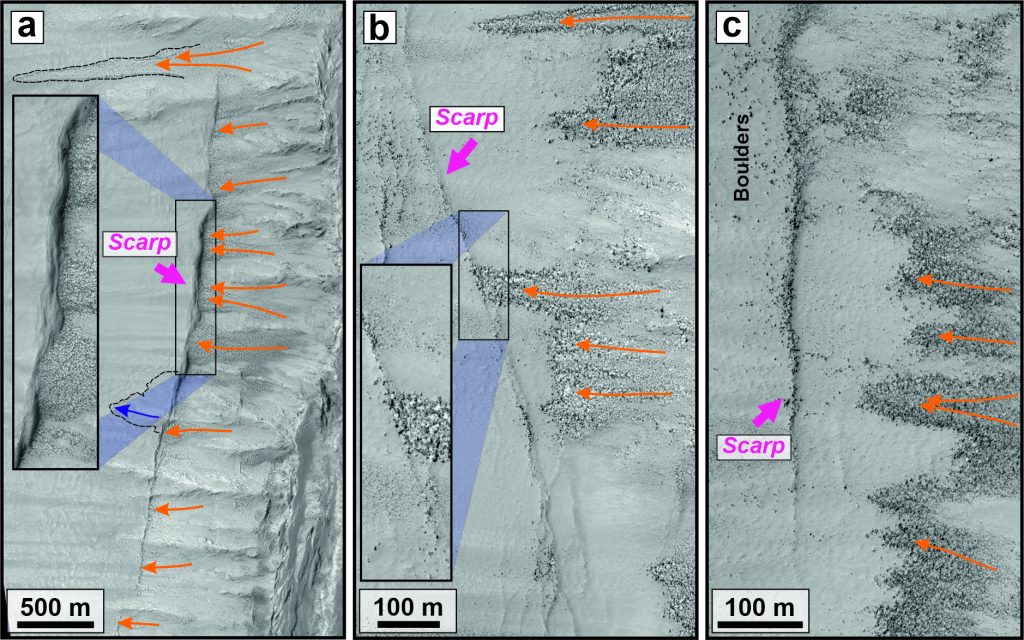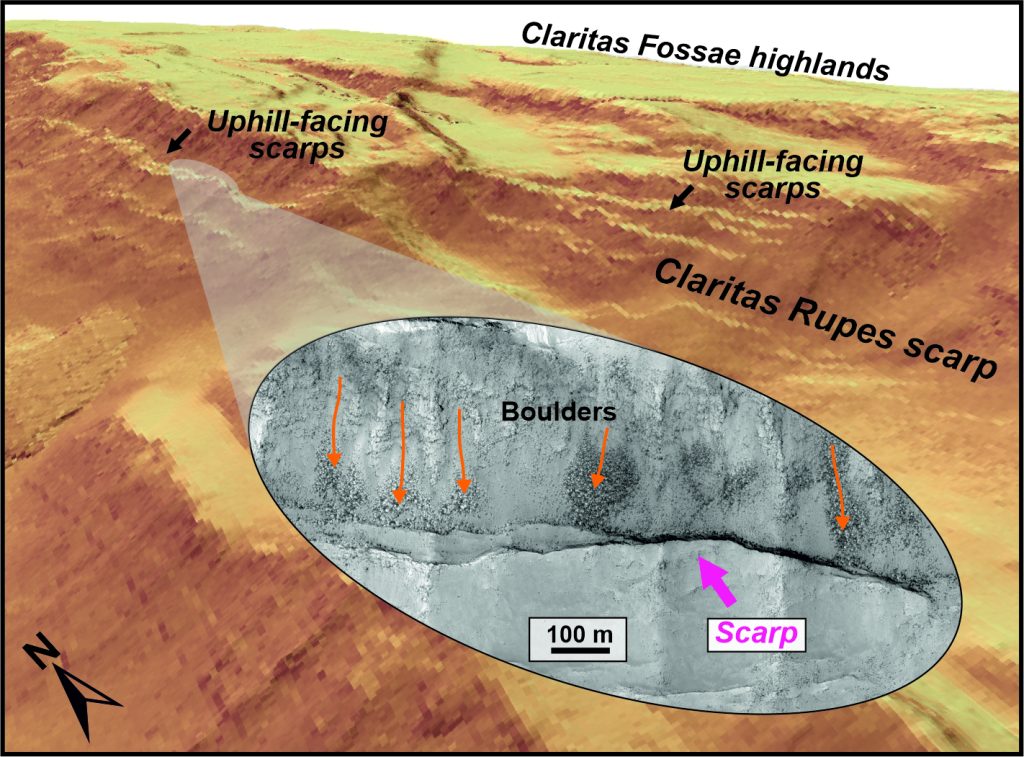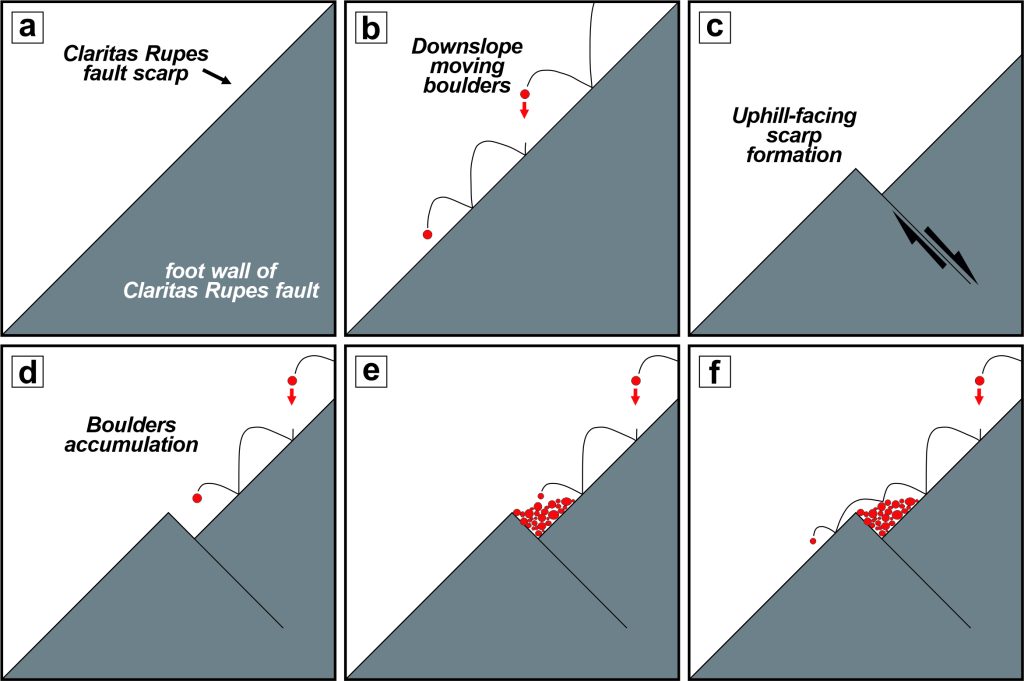GFÚ researcher Petr Brož (Surface Processes & Palaeoclimate) is a co-author of a new study exploring the endogenic activity on Mars in the south-eastern part of Tharsis, an area named Claritas Fossae.
The InSight mission of NASA has shown that Mars is still seismically active. During more than four years of operation (2019-2022), the probe’s seismometer SEIS had detected a total of 1,319 marsquakes of various magnitudes, which have significantly helped to improve our understanding of the red planet’s internal structure. However, none of the detected marsquakes can be linked to Tharsis, the largest volcano-tectonic province on Mars. This ~5,000 kilometres wide bulge deformed the surface of Mars and caused the cracking of martian crust. Since it takes a long time for the Martian subsurface to cope with the enormous load of Tharsis, it is possible that the surface may crack to this day, giving rise to Marsquakes. One reason for the difficulty to locate marsquakes in that region is that Tharsis’ position relative to InSight is in the shadow of the planet’s core, so any marsquakes in Tharsis would have escaped detection by SEIS. The search for recent traces of tectonic activity in Tharsis needs therefore to be done differently – by using remote sensing datasets that enables the identification of surface deformations possibly associated with the formation of marsquakes. A new study published in Icarus, has now revealed evidence of very recent faulting in Tharsis, confirming that Mars is not a tectonically dead planet.
Based on high resolution images taken by the HiRISE camera onboard the Mars Reconnaissance Orbiter, an international team of scientists led by Bartosz Pieterek from the Polish Geological Institute – NRI studied the south-eastern part of Tharsis, an area named Claritas Fossae. This region is dominated by a prominent topographic scarp, Claritas Rupes, which is several hundred kilometres long and up to 2-kilometres high. Superposed on this huge tectonic feature, which was formed more than 3 billion years ago, the scientists discovered a group of much smaller scarps with lengths of hundreds of meter-long and maximum heights of a few meters, which show a clear association with present-day rockfalls.
“To our surprise, these uphill-facing scarps are not covered by boulders and other debris from rockfalls that occur on steep slopes higher up on the main rupture of Claritas Rupes. Earlier studies suggested that the tectonic activity in this area had ceased around two and a half billion years ago, but our discovery shows that these small uphill-facing scarps have to be young. Indeed, very young! We do not know for sure when exactly these uphill-facing scarps were formed, but in geological terms, they have to be “young” as they are associated with, and partly younger than present-day surface processes,“ says Bartosz Pieterek.
“Talking about absolute ages, they are probably less than about one million years old. If they were older, they would be already covered by rocks that are constantly falling down the main Claritas Rupes scarp. Hence, we might witness an unexpectedly young tectonic activity here. So far, only few morphologically pristine tectonic structures have been found elsewhere on Mars, so the discovery of this very young faults improves our knowledge of where and how often the Red Planet might have been internally active in the recent past,” adding Petr Brož from the Institute of Geophysics of the Czech Academy of Sciences, a co-author of the study.
The Claritas Fossae region, alongside the Cerberus Fossae region located in Elysium Planitia, where InSight detected several strong marsquakes in association with a series of very young trenches, might host some of the youngest tectonic activity on Mars. Until another seismometer is placed on Mars that can detect marsquakes in Tharsis, image analysis will be the only way to find their traces. As this study shows, a lot about the recent tectonically active centers associated with Tharsis can still be learned. All that has to be done is to carefully look for small-scale, meter-sized fractures on the surface of Mars. Therefore, the ability to acquire very high-resolution images is critical for a better understanding of the planet’s evolution, and selecting the most promising sites on Mars for further studies.

Examples of fresh-looking scarps mapped within the studied region at the Claritas Rupes scarp that stopped and accumulated boulders along their strike. Orange solid lines with arrows indicate the downslope direction of boulder movement.

A 3D view of the major Claritas Rupes scarp which hosts clusters of pristine uphill-facing scarps. The zoom-in HiRISE-based image shows the accumulations of downslope moving boulders stopped by the scarp.

Schematic drawing presenting the formation of uphill-facing scarps at Claritas Rupes fault scarp in relation to downslope moving boulders.
Contacts for media:
Bartosz Pieterek (Poland, Polish Geological Institute – National Research Institute and Adam Mickiewicz University in Poznań); leading author of the study bpieterek94@gmail.com
Petr Brož (Czechia, Institute of Geophysics of the Czech Academy of Sciences); co-author petr.broz@ig.cas.cz
Ernst Hauber (Germany, German Aerospace Center DLR); co-author ernst.hauber@dlr.de
Link to the publication Recent faulting at the Claritas Rupes scarp on Mars:
https://www.sciencedirect.com/science/article/pii/S0019103524002586?via%3Dihub
Link to the figures:
https://www.dropbox.com/scl/fo/n6zg82poug7z2egxdgvj3/AIwMK7j–Hun7fmIHdP3De0?rlkey=ldg1dwjbqrl2wvbsmtfqufv0z&dl=0

